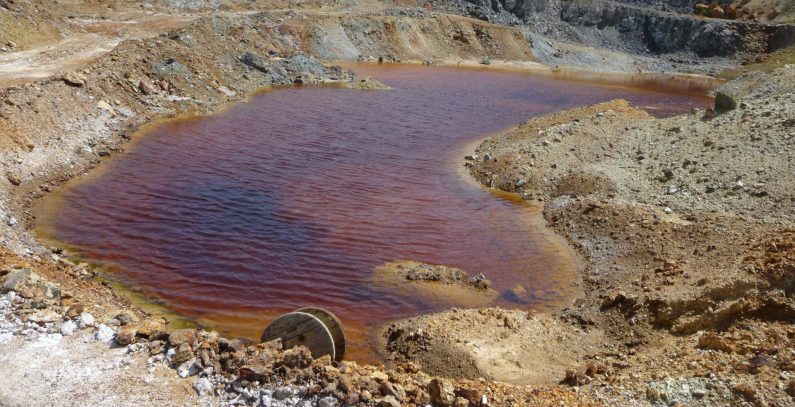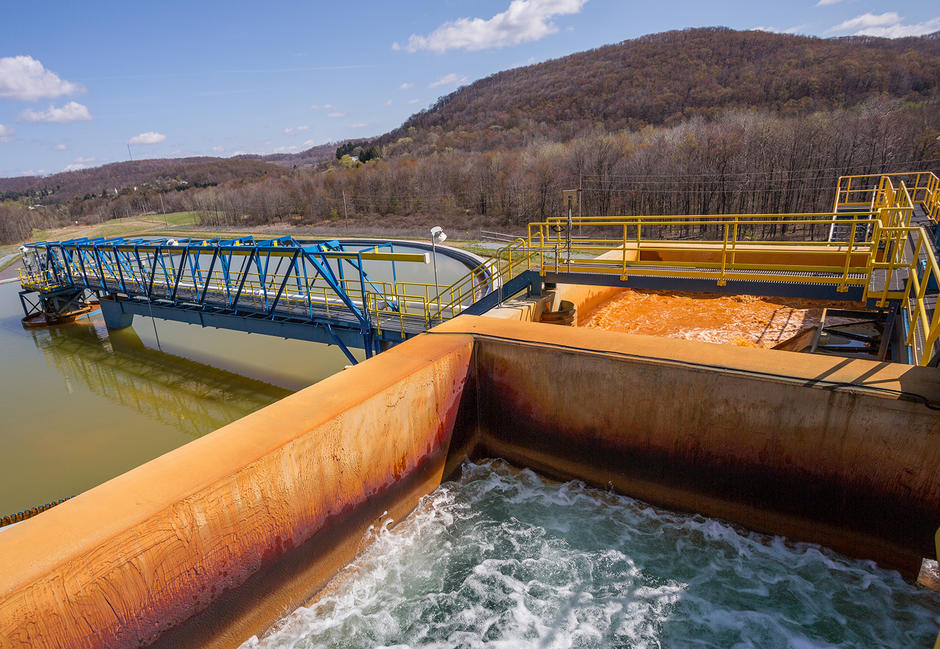Where are mineral processing wastewater come from

Generally speaking, all external drainage in the production process of mineral processing plant is collectively referred to as mineral processing wastewater, specifically including:
(1) Mine washing wastewater: contains a large amount of fine-grained slime and a small amount of ore particles;
(2) Wastewater from the crushing system: mainly contains ore particles, which can be reused after sedimentation;
(3) Equipment cooling water: including the cooling water of the crusher, the ball mill and the water sealing water of the vacuum pump, the water volume is small, and the pollutants are mainly oily substances, which can be recycled after treatment;
(4) Gravity and magnetic separation wastewater: mainly contains mineral particles and suspended solids, which can be basically reused after clarification;
(5) Flotation wastewater: mainly from the overflow water and tailings pond overflow water produced after concentrate and tailings pass through the two-stage dehydration process of thickening and filtration, and contain flotation reagents and a small amount of suspended solids;
(6) Flushing wastewater: the ground flushing water of each workshop;
(7) Others: “dripping and leaking” water in the beneficiation process and the drainage of the accident pool.
Characteristics of mineral processing wastewater
- Large emissions
- High content of suspended solids and total dissolved solids
- The composition is complex
The beneficiation wastewater of most mines contains copper, lead, zinc, cadmium, germanium, chromium, arsenic, and other heavy metal ions to varying degrees. Due to the non-degradability of heavy metal ions, they will be latent in the water body for a long time, making it an effective treatment for beneficiation wastewater difficulty.
Residual chemicals are mainly collectors, foaming agents and regulators added during the flotation process, which are the main causes of water chemical oxygen demand (COD), biochemical oxygen demand (BOD), pH value (strong acid or high alkali). ) and other major factors that exceed the standard.
Hazards of mineral processing wastewater
Mainly in the following aspects:
(1) The discharge of strong acid or strong alkaline wastewater will reduce the self-purification function of the received water body, endanger the growth of algae, fish and other aquatic animals and plants in the water, and in severe cases will lead to the death of aquatic organisms.
(2) The suspended solids in the wastewater will reduce the transparency of the water body, affect the photosynthesis of phytoplankton, aggravate the eutrophication of the water body, and destroy the ecological environment of the water body.
(3) Wastewater containing a large amount of heavy metal ions is discharged into the water body or soil, and absorbed into the body through the roots of plants. Excessive amounts will affect the growth and development of plants, and in severe cases will lead to plant withering and death; excessive heavy metals can also cause aquatic animal organisms. Metabolic disorders, inducing diseases, affecting development; the most serious is that it can endanger human health through enrichment in the food chain.
(4) Residual agents in wastewater, such as xanthate, can be directly decomposed to generate carbon disulfide under acidic conditions, polluting the environment; xanthate can also affect the growth of aquatic phytoplankton, and the concentration of isopropyl sodium xanthate is more than 5mg/L. The body of water can kill all duckweeds within 3 days.
Common treatment technologies for mineral processing wastewater
(1) Natural purification method

The natural purification method often uses the tailings pond as a structure, and the wastewater is transported to the tailings pond through pipelines, where precipitation, hydrolysis, oxidation, volatilization, photodegradation and even biological decomposition occur in the silo, reducing the concentration of suspended particles and residual chemicals, and even Basic removal. The effect of natural purification is related to factors such as exposure time, light intensity, water temperature, initial pH value, and dissolved oxygen. Generally, the longer the exposure time, the stronger the light intensity and the higher the temperature, the better the natural purification effect. The natural purification method can usually be used as a pretreatment method for mineral processing wastewater, or for the treatment of heavy and magnetic separation wastewater with relatively simple components.
(2) Acid-base neutralization method
The acid-base neutralization method includes the reaction of H+ (or OH- of alkaline wastewater) in acidic wastewater and OH- (or H+) in neutralizer to generate neutral water molecules. At the same time, the appropriate alkalinity of the pulp is required. It is also conducive to the reaction of heavy metal ions and hydroxide ions to form insoluble hydroxide precipitation, thereby eliminating heavy metal pollution.
Commonly used neutralizers in production practice include lime, slaked lime, sulfuric acid, alkaline waste water residue (carbide slag, etc.), acid waste water and waste gas (CO2, SO2 and their solutions, etc.). In theory, all heavy metals can be precipitated in a certain pH range, so controlling the pH value is the key to the neutralization method.
The acid-base neutralization method has the advantages of convenient management, low cost, simple operation, large processing capacity, strong adaptability and stable operation, but there are also some problems, such as serious scaling of equipment and pipe walls when neutralizing with lime , The sludge increment is large, and it is easy to produce secondary pollution.
(3) Coagulation sedimentation method
Coagulation sedimentation method is a relatively mature method for treating mineral processing wastewater at present, and it is often combined with activated carbon adsorption or oxidation method to form coagulation sedimentation-activated carbon adsorption method and coagulation sedimentation-oxidation method. The principle of coagulation purification is that the coagulant destabilizes the colloidal particles dispersed in the wastewater through electrical neutralization and electric double layer compression, coagulation net capture-co-precipitation, and polymer bridging and entraining, and then condense into Large particle flocs and eventually settle down.
The agents used in the coagulation and sedimentation method mainly include two categories of coagulants and flocculants. The coagulants mainly include ferric chloride, ferric sulfate, aluminum sulfate, aluminum chloride, polyaluminum chloride (PAC), polyferric chloride (PFC), polyferric sulfate (PFS), etc. Acrylamide (PAM). Coagulation and sedimentation method can effectively remove suspended particles and some heavy metal ions in beneficiation wastewater, and is a mature, stable and efficient wastewater treatment method.
(4) Chemical oxidation method
Chemical oxidation is an effective method for deep treatment of residual flotation reagents in beneficiation wastewater. The essence of chemical oxidation is that the oxidant oxidizes organic pollutants to non-toxic or low-toxicity by capturing H atoms in organic pollutants in wastewater. small molecular substances, or converted into substances that are easily separated from water, thereby reducing the COD and BOD of wastewater. Common oxidants are ozone, Fenton reagent, hydrogen peroxide, sodium hypochlorite, etc.
Chemical oxidation treatment of mineral processing wastewater has the characteristics of stable operation, thorough reaction, high treatment efficiency and can improve the biodegradability of wastewater.
(5) Constructed Wetland Method
Constructed wetland method is a new wastewater treatment technology developed in recent years. It is widely favored by scholars at home and abroad because of its ecological treatment concept. Constructed wetlands are shallow waters with flowing or static water bodies that are artificially constructed and participate in supervision and control after natural wetlands. Microbial ingestion, decomposition and other ways to remove pollutants in wastewater, give full play to the synergistic effect of physics, chemistry and biology.
The constructed wetland method provides a green and ecological technical route for the treatment of mineral processing wastewater, which is in line with my country’s basic national policy and has broad prospects for promotion. However, there are also limitations such as easy blockage of substrates, large area, and great interference by climate and other factors.
Due to the different properties and sorting methods of various metal and non-metallic minerals, the properties and components of mineral processing wastewater produced by mines are also different. The appropriate wastewater should be selected according to the properties of wastewater from different sources and the requirements of the beneficiation process on the properties of the return water. Treatment technology and wastewater reuse method, minimize the impact of backwater use on production technical indicators, rationally allocate and use beneficiation wastewater, make the maximum amount of beneficiation wastewater recycled in the beneficiation process, and control and reduce the external discharge of beneficiation wastewater. Improving the recycling rate of beneficiation wastewater and realizing the clean discharge of wastewater is the main development direction of my country’s mine development in the future, and it is a necessary means for enterprises to achieve sustainable development.